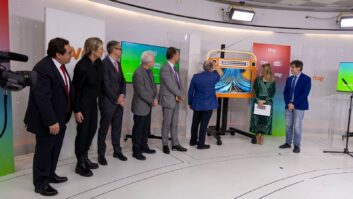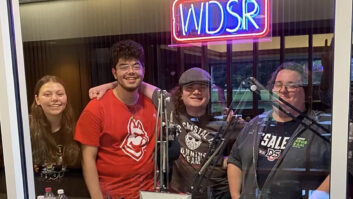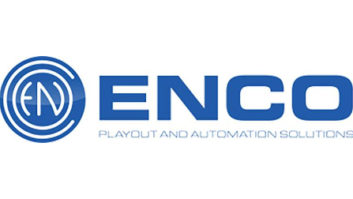WPIG Makes a Huge Technological Leap
Feb 1, 2010 12:00 PM, By Tom Atkins
Facility Showcase, Feb 2010

WPIG’s on-air studio features a Logitek Remora-10 console.
Re-building a radio studio is a pretty straightforward task. Though there are different levels of intricacies, you would usually move the studio operation into a temporary room, rebuild the old studio, then move the operation back into the newly outfitted room. The time involved would, of course, depend on the level of the rebuild, but moving the operation into another room temporarily makes the job go much easier. What if you were given the task of rebuilding radio studios while keeping the operation running from the same studios you were tasked to rebuild? This was the job at hand at our FM/AM combo in Olean, NY.
WPIG and WHDL badly needed a rebuild. The automation was still the DOS-based DCS system from Computer Concepts and most of the audio consoles were even older. The operation, though at once state of the art had over a 20-plus year time span, become unreliable and the sound quality had deteriorated. The studios, originally built in the 1930s, are nestled in the Southern tier of Western New York near the New York/Pennsylvania border an hour and a half drive south of Buffalo. Originally, the building was home only to WHDL-AM until The FM (WHDL-FM) came along in 1947. It is now the heritage super power class B FM country station WPIG. There are three studios, two air, one production room and a combined rack and engineering room involved in this job. The AM transmitter is co-located here as well. Needless to say, space was limited, thus the need to rebuild around the present operation.

WHDL’s on-air studio
— continued on page 2
WPIG Makes a Huge Technological Leap
Feb 1, 2010 12:00 PM, By Tom Atkins
Facility Showcase, Feb 2010
Where to begin
The first need was to select a state-of-the-art automation system that would give a good amount of flexibility to the operation. Backup was also an important aspect. The automation system needed to have the ability to keep the stations on the air if a central server failed or one of the main on-air work stations failed. Ease of setup was a must and we wanted to be able to stream WAV files from a central server over Ethernet. Another primary focus in the automation decision was its ability to run with off-the-shelf hardware if need be, in case of failure. This was very important. Being located in a smaller town, a hardware failure could mean those dreaded three words: Off the air.

WPIG/WHDL production room
In the early days of automation, hardware specifications were finite, but I am sure that having the ability to put an off-the-shelf sound card, or for that matter, an off-the-shelf work station to use would be a distinct advantage, at least for the short term. You know the scenario, a major failure happens on a holiday weekend and you cannot get parts. Given all these requirements, Media Touch from OMT was selected as the automation system of choice. The hardware purchased included five workstations, two for each on-air studio and one for production, a central server with a RAID five hard drive array, a gateway workstation, and an additional workstation to run the Media Touch logger software to record network feeds and air checks.
All workstations except for the gateway were outfitted with M-Audio Delta audio cards affording the station balanced inputs and outputs. The gateway workstation’s mission in life is to be the location audio files, log files and any other files that need to be put into the automation system from outside the system, are deposited, scanned for any infections, and then copied to the appropriate destination in the automation. As a company, we do not allow the automation system to be directly connected to the Internet. The reasons are many but the most important is that we do not want to render the on-air product useless due to an infection being passed along to it. So, we take extra precautions in this area. I mentioned previously that one of the requirements of the automation system was to stream WAV files on the automation network. Backyard Broadcasting does not condone the use of compressed audio formats, especially for the music. A new music library was purchased for WPIG to use when the new automation system was installed. We have changed music libraries in many of our markets and the difference between compressed and linear non-compressed is dramatic. With hard drive space so cheap, there is absolutely no reason to have a compressed library, unless you are working with legacy equipment and it would not support the larger files. WHDL did not have to go this route as it runs a 24-hour satellite delivered format called Kool Gold from Dial-Global.
In-place progress
Rebuilding studios around the existing operation has many challenges. Given its number of years, there was existing wiring. Not just a little. A lot. Actually more than a lot. Just like any other broadcast facility, the original wiring was added to, and added to, and added to over the years for modifications and new equipment. This left the original wiring path to the studios looking like 20 pounds of bologna in a 5-pound bag. New wiring had to run overhead in a new path and be kept to a minimum as space was limited. Also, remember that the current operation had to continue. In order to accomplish this task, traditional audio consoles with all the ins and outs in the actual console had to be ruled out. The decision was made to go with an audio router-based console system. This way we can keep most of the audio sources and destinations wired in the rack room. Sources such as microphones and CD players along with destinations like headphone and studio monitor amps would be part of the new cabling to and from the studios thus minimizing the actual audio runs to and from the studios. Logitek Remora consoles and audio engine were chosen as they fit all the requirements and cost guidelines for the project, not to mention that this system will afford us the ability to have virtually every source in the building available for selection on the three Remora consoles.
With the two main components ordered, it was time to create room in the existing racks for the new Media Touch automation and Logitek Audio Engine. The existing racks housed many gems not being used anymore including an old cart carousel once used for automation. Audio still being used in the existing operation was still running through the old patch bays so care had to be taken in removing some of the items. In some instances, temporary wiring had to be put in place to bypass these relics. Keep in mind that with this type of rebuild, and the lack of available space, you wind up moving items in the racks two or three times before they find their final physical location. Does this add time to the project? You betcha!
— continued on page 3
WPIG Makes a Huge Technological Leap
Feb 1, 2010 12:00 PM, By Tom Atkins
Facility Showcase, Feb 2010
The good folks at Logitek provide pre-wired cables to most flavors of termination blocks at different lengths. The option here was to terminate all the analog audio ins and outs into 66 blocks from the Logitek audio engine. The Logitek Audio Engine has the option for AES/EBU in and out. However, in this particular installation, the majority of our sources and destinations in the market were analog and the need for AES/EBU was small to none. Thus the Audio Engine was purchased without any AES/EBU cards in it. Though if need be, we can add AES/EBU functionality by the addition of an audio card in the Audio Engine.
Also added were 66 block terminations to the newly run cables to and from the three studios. While on the subject of the studio cable runs, traditional multi-pair shielded cables were used for the analog audio runs. Also included were CAT-5e 25-pair cables for computer network connectivity to the rooms and the RS-422 communication lines necessary for the Remora Consoles to communicate with the audio engine. These 25-pair cables were also terminated in 66 blocks that are CAT-5e compliant. The only computer network connectivity that did not take advantage of the cables was the automation network, which was set up for gigabit speed. Most of the automation network connections to the switch were kept in the rack room since many of the automation workstations were physically installed there. So the CAT-6 cables were kept short. For the workstations located in the studios for production, a commercially made CAT-6 cable was purchased and run into the rooms directly from the automation switch.
Punchin’ and grinnin’

Relics in the rack: WPIG’s carousel.
As a very good friend once said, �If you have all your terminations, it is time to be punchin’ and a grinin’.� Yes, cross connecting was next on the agenda. Since most of the audio sources and destinations would remain in the rack room, cross connecting was short and to the point. On the automation side, the keyboards, video for the monitors, and the mice connections were remoted to the air studios with Avocent KVM extenders. Connectivity from the local to the remote KVM was accomplished through CAT-5e cables. In this instance, we utilized the 25-pair runs into the rooms. The only workstations that did not have KVM extenders on them were workstations designated for production. Here it was deemed better to have the workstations in the rooms so access to CD/DVD drives were available.
With everything in place, and all the cross connections made, it was time to cut over to the new systems. To accomplish this task without losing any air time, we had to run the on-air for each studio out of the production room one at a time for an evening each. The old equipment of each room was removed along with the old wiring. As I mentioned earlier, there was a heroic amount of legacy cables in the studios. They were all cut and pulled out to make room under the counter tops. Once the room was cleared, the new equipment was brought in and connected. Each room took approximately six to eight hours to strip down and then re-populate with the new equipment. Having everything pre-wired ahead of time also helped in this venture. For those of you keeping count, the production room was last in the upgrade scheme.
With WPIG and WHDL comfortably using the new consoles and automation system, the decision to go with an audio router-based console system definitely made the job go easier considering everything that had to be danced around. It gave us the ability to pre-wire 80 percent of the connections without affecting the legacy operation as most were kept localized to the rack room. The hard part was doing a dance with legacy equipment that had their dance cards all filled over the 20-plus years of operation.
Atkins is VP, director of engineering of Backyard Broadcasting, Buffalo, NY.
— continued on page 4
WPIG Makes a Huge Technological Leap
Feb 1, 2010 12:00 PM, By Tom Atkins
Facility Showcase, Feb 2010
Equipment List
Acer LCD monitors
ART Clean Boxes, SLA-2
Avocent KVM extenders
Behringer Power Play Pro XL
Broadcast Tools 16.4
DBX 286
Furman power distribution panels
HP desktop workstation computers
Logitek Audio Engine, Remora, X-Y Select Panel
Media Touch
Omnia 5EXHD
Pro-Racks Media Touch Audio Server
Stanton C501
Telos 1X6
Tripp-Lite Smart Pro UPS

Ripping out legacy wires proved to be a heroic effort.

Ripping out legacy wires proved to be a heroic effort.

Mediatouch workstation computers and Broadcast Tools switcher in the rack room.
— continued on page 5
Contributor Pro-File: Tom Atkins
This month: Tom Atkins; Corporate VP/Director of Engineering; Backyard Broadcasting; Buffalo, NY…
WPIG Makes a Huge Technological Leap
Feb 1, 2010 12:00 PM, By Tom Atkins
Facility Showcase, Feb 2010





















